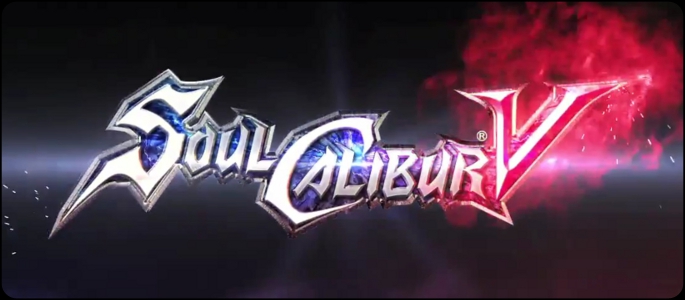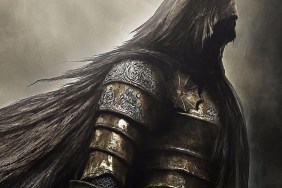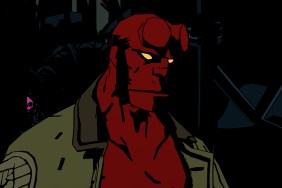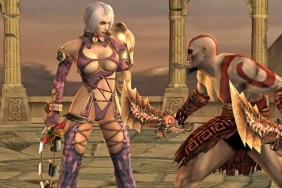SoulCalibur IV released during the hot summer of 2008. The way the Project Soul team spoke about the venerable fighter, it was going to be the last of the series, since rumors were abound that the team was defunct. Fast forward to 2011, and thanks to fan response and numerous online petition signatures, SoulCalibur V was announced, to be released the then-upcoming January. So the final version of SoulCalibur has arrived, but is it the tour-de-force that the series deserves to go out on? Let’s find out.
For SoulCalibur fans, you will feel right at home here. The fighting is tight, and the graphics soothe the eyes (yes, jiggling breasts are here too – though they are much less obvious in most outfits). There is a wide range of arenas to choose from, and the audio is equally stunning. Throughout all these years, it is amazing that the SoulCalibur series has never lost its sense of grandeur while simultaneously maintaining a genuine arcade quality that’s difficult to pinpoint. I suppose the same could be said for all fighting games with time limits and “Continue?” options after each lost match, but I think it’s the in-game voiceover work for each introduction of the selected stage that really helps draw you in and remember the good ol’ days in the arcade. It feels a lot like SoulCalibur IV, which is good for fans.
However, a lot has changed since SoulCalibur IV was gracing our screens. For starters, Mortal Kombat showed the world that there was still plenty of life in that series, and also it also proved fighting games could have a coherent and enjoyable story in their single player campaigns. SoulCalibur V definitely stumbles here when it comes to storytelling. The single player campaign revolves around a few of the new characters, focusing mostly on Patroklos and his quest to rescue his sister, Pyyrha. It’s a pretty tired storyline from the get go, and a lot of it is easily predictable. This would be tolerable on its own with normal cutscenes. But sometime during development Namco decided it would be a good idea to only utilize in-game cutscenes for a portion of them. The rest? Well, they’re these sketch-like storyboards which have full voiceover work and sound effects played while the camera pans across the images. I’m baffled as to why Namco decided to present cutscenes in such a manner. Some (read: a select few) hardcore SoulCalibur fans may get a kick out of this as it appears to be concept art/storyboards, but most gamers will not be impressed. It seems rushed, like perhaps Namco ran out of time or it was a budget constraint. But when all the voicework and sound effects are completed, it doesn’t seem like too much to ask for to just use the game engine that’s already there and render the cutscenes.
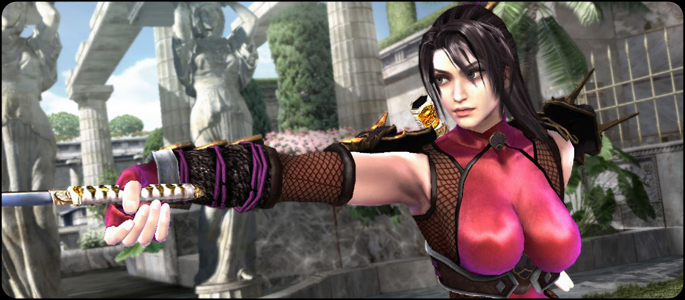
Another key aspect that SoulCalibur V just did not get right is the game’s difficulty level. Throughout the campaign, don’t expect much of a fight from the CPU. Until, that is, you get to the Nightmare stage. There are some lesser enemies you have to take out first, but still they pose little threat. Once Nightmare is thrown into the ring, you had better have complete knowledge of Patroklos’ moveset before attempting to defeat this opponent. Suddenly, the game goes into hit-or-be-killed mode, and you will want to throw your controller across the room. Turning down the difficulty at the end of your loss is pretty much your only option, unless you are a certain breed of masochistic. The same goes for ranked offline arcade sessions, except you cannot turn down the difficulty level.
But fighting games aren’t really all about the single player experience. On the contrary, in fact. Fighting games are meant to be enjoyed by multiple people! SoulCalibur has always been great for multiplayer. That rings just as true as ever in SoulCalibur V. Unfortunately, the options here are pretty limited offline. First, the game is strictly a two-player affair on one console. No tag teaming here. It’s actually pretty pale in comparison to other fighting games offline. Online, however, you do have some more modes at your disposal. You can have up to six players in one room in a player match, and the Global Colosseo is a cool take on online lobbies. Using a stock or custom-made card avatar, players can congregate around areas in a regional room. You can move this card around the room, chatting amongst other players and challenging them to duels. If you’d rather just get straight to fighting, there are occasionally tournaments held in the center of these lobbies, as is a section to get paired up with another competitor in the room without looking for them. It’s a cool, casual environment and most people seem friendly to talk to, and they are there to discuss all things SoulCalibur as well as play a few rounds. Two dings for this game’s online modes – it takes too long to get an actual game going, and disconnects happen with alarming frequency (though of course your mileage may vary).
SoulCalibur V has the series at odds. It’s a competent fighter, yes, but nothing about it really screams “must-have” unless you are a diehard SoulCalibur fan. The fighting system is more or less the same, and even the “new” Critical Edge moves don’t do much to change up strategies. The single player difficulty spike towards the end of the campaign signals not enough time was spent tweaking the game, and the story is contrived, over-acted, and filled with boring “cutscenes” if the term may be used loosely. However, the multiplayer does its job at maintaining a good level of pure arcade fun, and the in-game titles you can earn provide some incentive to play other single player modes. It’s not a bad fighting game by any means. It’s just, if Project Soul is truly leaving us, then you’d kind of expect a more glorious goodbye.
PlayStation LifeStyle’s Final Score
+/- More of the same SoulCalibur fighting system. Not much is new. – Boring story, aggravating difficulty ramp up in single player. |
 |
